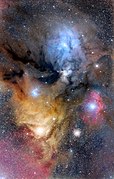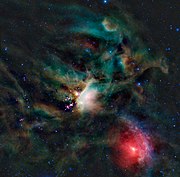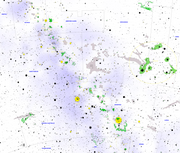Rho Ophiuchi cloud complex
| Apparent dimensions (V) | 4.5° × 6.5°[5] |
|---|---|
| Constellation | Ophiuchus |
| Designations | Ophiuchus molecular cloud, Integral 691, XSS J16271-2423 |
The Rho Ophiuchi cloud complex is a complex of
Cloud complex
This cloud covers an angular area of 4.5° × 6.5° on the celestial sphere. It consists of two major regions of dense gas and dust. The first contains a star-forming cloud (L1688) and two filaments (L1709 and L1755), while the second has a star-forming region (L1689) and a filament (L1712–L1729). These filaments extend up to 10–17.5 parsecs in length and can be as narrow as 0.24 parsecs in width. The large extensions of the complex are also called Dark River clouds[8] (or Rho Ophiuchi Streamers) and are identified as Barnard 44 and 45. Some of the structures within the complex appear to be the result of a shock front passing through the clouds from the direction of the neighboring Sco OB2 association.[5]
Temperatures of the clouds range from 13–22 K, and there is a total of about 3,000 times the
The first
The 2023
Gallery
-
Rho Ophiuchi Region, with the mainρ Ophiuchi at the center of the large blue area (IC 4604), Antares in the large yellow area and Sigma Scorpii in the redish Sh2-9 area, with Messier 4inbetween the latter two stars. North is up. July 2, 2019 photo by Adam Block.
-
The Rho Ophiuchi cloud complex with its main dark nebula Lynds 1688, speckled with its pinkish young stellar objects, just left to HD 147889 surrounded by IC 4603 as the bright area at the center. The red area called Sh2-9 has Sigma Scorpii at its center, and Antares is just outside the picture at the bottom.
-
The large multicoloured Rho Ophiuchi cloud complex with the Dark River clouds (or Rho Ophiuchi Streamers) asDschubbaat its center.
-
Astarchart of the Galactic Centerarea, with the Rho Ophiuchi cloud complex marked as large green area in the middle of the right half of the chart.
-
Map of the molecular clouds within 1000 parsecs, the Sun is at the center.
-
Main dark nebulae of the Solar apex half of the galactic plane, with the Rho Opiuchi cloud complex at the right edge
-
The Milky Way as seen by Gaia, with prominent dark features labeled in white, as well as prominentstar cloudslabeled in black. Rho Ophiuchi is on the left top center.
See also
- Cygnus X
- List of nearby stellar associations and moving groups
- Orion molecular cloud complex
- Perseus molecular cloud
- Taurus molecular cloud
References
- ^ . Retrieved July 12, 2023.
- ^ "Rho Ophiuchi (NIRCam Image)". Webb Space Telescope. Space Telescope Science Institute. 12 July 2023. Retrieved 14 July 2023.
- ^ a b "RHO OPH REGION -- Molecular Cloud". SIMBAD. Centre de Données astronomiques de Strasbourg. Retrieved 2009-10-24.
- ^ S2CID 17270972.
- ^ doi:10.1086/167244.
- ^ "Young Stars in Their Baby Blanket of Dust". Spitzer Multimedia Features. NASA. 2008-11-02. Retrieved 2009-10-24.
- ^ a b Miller, Katrina (12 July 2023). "A Year of Cosmic Wonder With the James Webb Space Telescope - With a new image, NASA commemorates the first anniversary of doing science with the most powerful observatory ever sent to space". The New York Times. Archived from the original on 12 July 2023. Retrieved 13 July 2023.
- ^ a b "APOD: 2010 July 19 - Dark River Wide Field". Astronomy Picture of the Day. 2010-06-06. Retrieved 2021-08-06.
- doi:10.1086/161482.
- S2CID 119393698.
- ISBN 3-540-42353-2.
- ^ Grosso, Nicolas (May 7, 2002). "Infrared Images of an Infant Solar System". Press Releases. European Southern Observatory. Retrieved 2009-10-25.
- STScI. 2023-07-12. Retrieved 2023-11-05.
External links
- Astronomy Picture of the Day
- The Colorful Clouds of Rho Ophiuchi 2007 September 3
- Young Stars in the Rho Ophiuchi Cloud 2009 November 13
- Rho Ophiucus Wide Field 2010 May 24
- Colorful Clouds Near Rho Ophiuchi 2012 August 28



![The large multicoloured Rho Ophiuchi cloud complex with the Dark River clouds (or Rho Ophiuchi Streamers) as Barnard 44 and 45 on the right, seemingly radiating towards the distant Pipe Nebula and the Galactic Center, extending from the core L1688 as well as L1689 dark nebulae.[8] In the lower part of this wide field image the distinct blue eyed (Nu Scorpii) Blue Horsehead Nebula can be seen. The blue area at the back of the head is IC 4601. The cloud in the top left corner is LBN 1093 and Sh2-1 with the bright star being Pi Scorpii and the yellowish cloud in the middle on the left being Sh2-7 with Dschubba at its center.](http://upload.wikimedia.org/wikipedia/commons/thumb/9/98/Rho_Ophiucus_Widefield.jpg/180px-Rho_Ophiucus_Widefield.jpg)



